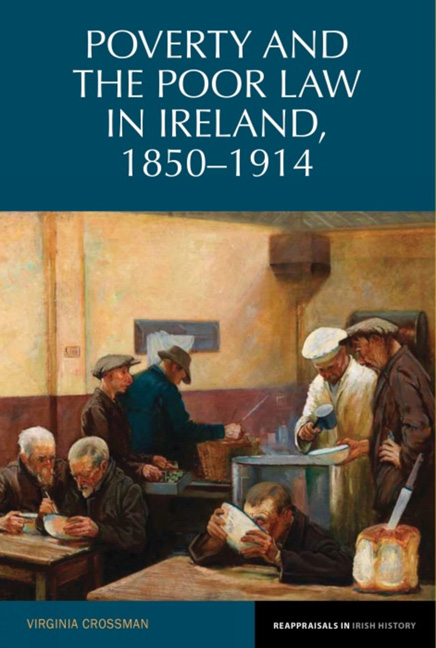Book contents
- Frontmatter
- Contents
- List of Figures
- List of Tables
- List of Maps
- Acknowledgements
- Introduction
- Chapter 1 Concepts of Poverty and Poor Relief
- Chapter 2 Context and Trends
- Chapter 3 Outdoor Relief
- Chapter 4 The Workhouse
- Chapter 5 The Sick, Infirm and Lunatics
- Chapter 6 Single Mothers and Prostitutes
- Chapter 7 Mendicancy and Vagrancy
- Conclusion
- Note on statistics and Sources
- Bibliography
- Index
Chapter 4 - The Workhouse
- Frontmatter
- Contents
- List of Figures
- List of Tables
- List of Maps
- Acknowledgements
- Introduction
- Chapter 1 Concepts of Poverty and Poor Relief
- Chapter 2 Context and Trends
- Chapter 3 Outdoor Relief
- Chapter 4 The Workhouse
- Chapter 5 The Sick, Infirm and Lunatics
- Chapter 6 Single Mothers and Prostitutes
- Chapter 7 Mendicancy and Vagrancy
- Conclusion
- Note on statistics and Sources
- Bibliography
- Index
Summary
The workhouse was central to the Irish poor law system. Any move to convert vacant workhouse buildings to other uses, Chief Commissioner Power insisted in 1859, would send out a very unfortunate message with regard to the poor law system as a whole. It should be remembered ‘above all things’, he observed, ‘that the whole poor law of an Irish union is concentrated in its workhouse; that the administration of relief in the union is good or bad according to the good or bad state of management of the workhouse’, and that state depended ‘on the strict enforcement of classification and the continued appropriation of the several parts of the building to the uses for which they were originally designed’. Power accepted that change was inevitable, but was confident that no change which was likely to be made ‘need be regarded with apprehension so long as the workhouses are left intact’. As he anticipated, the poor law system underwent fundamental revision in the succeeding decades yet workhouses remained intact and essential to relief administration. The physical edifice of the workhouse marked the site of relief, a manifestation of government concern for the destitute. The organisation of its interior imposed a semblance of order on lives disrupted by poverty and distress. This chapter adopts a split-screen approach to the workhouse. It provides an analysis of trends in occupation and usage, and an exploration of the institutional life of the workhouse, tracing the relief process from admission to discharge. Finally, it focuses on the experience of families within the workhouse, family separation being generally regarded as one of the cruellest aspects of the workhouse system.
Workhouses were a significant architectural feature in the Irish landscape. Generally built to accommodate between 500 and 900 people, they were positioned wherever possible on sloping sites that provided natural drainage. The ‘first intimation of approach to any town or district of consideration’ was thus ‘the appearance on rising ground of the tudor gables and lattice windows of the Union Workhouse’. An English visitor to Ireland in the early 1880s, William Hall, described Killarney Workhouse as typical of Irish workhouses in being ‘an imposing edifice, splendidly situated on high ground, with an air of neatness and finish on the outside’. Others reported less favourable impressions.
- Type
- Chapter
- Information
- Poverty and the Poor Law in Ireland, 1850–1914 , pp. 101 - 138Publisher: Liverpool University PressPrint publication year: 2013



